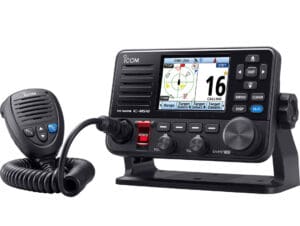by Ann Hoffner

A wellfound sailboat making its way across the South Pacific strikes a whale; within minutes water enters the bilge. It’s impossible to find the source and those on board decide to seek assistance. The crewmember assigned to communications hurries to the nav station, pushes the red distress button on the VHF radio. Why did they do that? It’s only a short range radio, how can it help from the middle of the ocean? Because the red button means its equipped with digital selective calling (DSC), and pushing that button automatically sent out a message and will keep on sending it to any vessels or stations in the area that also have DSC technology. The distress alert contains the name and description of the sailboat, who it is registered to, and contact persons. It will send out coordinates if connected to a GPS, and can be set up by the user to specify the nature of the emergency.
To make it work the sailboat must have applied for a marine mobile service identity (MMSI). This unique nine-digit number is assigned to the boat, not to a user. While all new marine VHF radios and many older ones include the distress button, a surprising number of vessel owners do not properly set up their radios and thus miss out on participating in the Global Maritime Distress and Safety System (GMDSS).
Though there has always been a law of the sea that nearby vessels must go to the aid of a vessel in distress, the means to do this has been codified in the last several decades in the GMDSS. This internationally recognized automated system connects ships at sea to each other, as well as to shore-based stations via satellites and terrestrial radios. Because it uses DSC technology to send information digitally rather than by voice, it increases the range of maritime communications, the accuracy of data transmitted, and the ability to direct that information especially when coordinating rescue operations from shore-based stations. Vessels in the GMDSS can receive safety information, like navigation hazards and weather conditions, and they can send and receive distress signals. It does not require you to have satellite communications or even HF radio though these may also be useful.
The GMDSS is mandated for commercial and passenger ships by the International Maritime Organization (IMO) Safety of Life at Sea Convention (SOLAS) which, depending on the areas they sail in, must carry MF/HF radio and satellite communications.
For a non-mandated vessel, i.e. a sailboat at sea, to be visible to the GMDSS system it must have a MMSI number. Ships that pick up a VHF transmitted DSC message may come to your aid or be able to communicate with shore-based stations via their own communications equipment.
It’s imperative to have a VHF radio that can be connected to a GPS receiver. If not, the DSC alert may contain all other pertinent information but lack a location for your vessel.
How you apply for a MMSI number depends on your float plan. Those intending to enter international waters must contact the FCC and file Form 605 to obtain a ship radio license and Schedule B for the MMSI. The FCC-assigned MMSI includes a country code which is recognized by foreign rescue operations. It’s advisable to keep track of your user name and password to retrieve your number should you lose it (www.fcc.gov/wireless/bureau-divisions/mobility-division/maritime-mobile/ship-radio-stations/maritime-mobile).
For boats that remain in inland or coastal US waters, it’s not necessary to obtain a federal ship’s license or number, and the whole process can be completed through organizations like BoatU.S. or the United States Power Squadron without navigating the dense bureaucratic government web. However, if you hop borders to Canada or Mexico your MMSI will not be recognized.
Handheld VHF radios can use the same MMSI as your main radio, but if you take a handheld from one boat to another you should apply for a unique MMSI for it.
MMSI numbers are also used to identify vessels on AIS. If you apply for a domestic MMSI your information cannot be tracked by government or private tracking services.
EPIRBs do NOT use MMSI numbers; they are issued identifiers unique to the EPIRB not the vessel.
